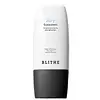What's inside
What's inside
 Key Ingredients
Key Ingredients

 Benefits
Benefits

 Concerns
Concerns

 Ingredients Side-by-side
Ingredients Side-by-side

Water
Skin ConditioningZinc Oxide
Cosmetic ColorantCyclohexasiloxane
EmollientDisiloxane
Skin ConditioningButyloctyl Salicylate
Skin ConditioningPropylene Glycol Dicaprylate
EmollientPropanediol
SolventMethyl Trimethicone
Skin ConditioningMethyl Methacrylate Crosspolymer
Diospyros Kaki Leaf Extract
Skin ProtectingVitis Vinifera Fruit Extract
Skin ConditioningCarthamus Tinctorius Flower Extract
Skin ConditioningCoffea Arabica Seed Extract
MaskingPolygonum Cuspidatum Root Extract
AntioxidantCamellia Sinensis Leaf Extract
AntimicrobialCastanea Crenata Shell Extract
Skin ConditioningZanthoxylum Piperitum Fruit Extract
Skin ConditioningPogostemon Cablin Leaf Oil
MaskingJuniperus Virginiana Oil
MaskingArtemisia Vulgaris Oil
PerfumingMentha Arvensis Leaf Oil
MaskingTriethoxycaprylylsilane
Lauryl Polyglyceryl-3 Polydimethylsiloxyethyl Dimethicone
Skin ConditioningSodium Chloride
Masking1,2-Hexanediol
Skin ConditioningPolyglyceryl-3 Polydimethylsiloxyethyl Dimethicone
Skin ConditioningGlyceryl Caprylate
EmollientCaprylyl Glycol
EmollientButylene Glycol
HumectantEthylhexylglycerin
Skin ConditioningTocopherol
AntioxidantWater, Zinc Oxide, Cyclohexasiloxane, Disiloxane, Butyloctyl Salicylate, Propylene Glycol Dicaprylate, Propanediol, Methyl Trimethicone, Methyl Methacrylate Crosspolymer, Diospyros Kaki Leaf Extract, Vitis Vinifera Fruit Extract, Carthamus Tinctorius Flower Extract, Coffea Arabica Seed Extract, Polygonum Cuspidatum Root Extract, Camellia Sinensis Leaf Extract, Castanea Crenata Shell Extract, Zanthoxylum Piperitum Fruit Extract, Pogostemon Cablin Leaf Oil, Juniperus Virginiana Oil, Artemisia Vulgaris Oil, Mentha Arvensis Leaf Oil, Triethoxycaprylylsilane, Lauryl Polyglyceryl-3 Polydimethylsiloxyethyl Dimethicone, Sodium Chloride, 1,2-Hexanediol, Polyglyceryl-3 Polydimethylsiloxyethyl Dimethicone, Glyceryl Caprylate, Caprylyl Glycol, Butylene Glycol, Ethylhexylglycerin, Tocopherol
Water
Skin ConditioningIsononyl Isononanoate
EmollientZinc Oxide
Cosmetic ColorantTitanium Dioxide
Cosmetic ColorantSilica
AbrasiveDicaprylyl Carbonate
EmollientCyclopentasiloxane
EmollientDimethicone Crosspolymer
Emulsion StabilisingCeramide NP
Skin ConditioningCeramide AP
Skin ConditioningCeramide EOP
Skin ConditioningPhytosphingosine
Skin ConditioningTocopheryl Acetate
AntioxidantPropanediol
SolventSqualane
EmollientC14-22 Alcohols
Emulsion StabilisingC12-20 Alkyl Glucoside
EmulsifyingEmulsifying Wax Nf
Polyacrylate Crosspolymer-6
Emulsion StabilisingNiacinamide
SmoothingXanthan Gum
EmulsifyingPhenoxyethanol
PreservativeEthylhexylglycerin
Skin ConditioningWater, Isononyl Isononanoate, Zinc Oxide, Titanium Dioxide, Silica, Dicaprylyl Carbonate, Cyclopentasiloxane, Dimethicone Crosspolymer, Ceramide NP, Ceramide AP, Ceramide EOP, Phytosphingosine, Tocopheryl Acetate, Propanediol, Squalane, C14-22 Alcohols, C12-20 Alkyl Glucoside, Emulsifying Wax Nf, Polyacrylate Crosspolymer-6, Niacinamide, Xanthan Gum, Phenoxyethanol, Ethylhexylglycerin
 Reviews
Reviews

Ingredients Explained
These ingredients are found in both products.
Ingredients higher up in an ingredient list are typically present in a larger amount.
Ethylhexylglycerin (we can't pronounce this either) is commonly used as a preservative and skin softener. It is derived from glyceryl.
You might see Ethylhexylglycerin often paired with other preservatives such as phenoxyethanol. Ethylhexylglycerin has been found to increase the effectiveness of these other preservatives.
Propanediol is an all-star ingredient. It softens, hydrates, and smooths the skin.
It’s often used to:
Propanediol is not likely to cause sensitivity and considered safe to use. It is derived from corn or petroleum with a clear color and no scent.
Learn more about PropanediolWater. It's the most common cosmetic ingredient of all. You'll usually see it at the top of ingredient lists, meaning that it makes up the largest part of the product.
So why is it so popular? Water most often acts as a solvent - this means that it helps dissolve other ingredients into the formulation.
You'll also recognize water as that liquid we all need to stay alive. If you see this, drink a glass of water. Stay hydrated!
Learn more about WaterZinc Oxide is a mineral broad-spectrum UV filter; it is the broadest UVA and UVB reflector approved by the FDA. It also has skin protectant and skin soothing properties.
Zinc oxide is one of the most effective broad-spectrum UV filters. It protects against UVB, UVAII, and UVAI. In comparison to its counterpart titanium dioxide, zinc oxide provides uniform and extended UVA protection.
Another great benefit? This ingredient is highly photostable so it won't degrade easily under sunlight.
A common myth is that mineral UV filters are widely believed to primarily reflect UV light.
However, modern research shows titanium dioxide absorbs UV radiation like chemical filters (~95% absorption & 5% reflection).
Zinc oxide has great skin soothing properties so you'll likely find this in sunscreens formulated for sensitive skin or babies/children. It is unlikely to cause "eye sting" like other sunscreen ingredients.
Regulatory agencies consider zinc oxide to be non-toxic and safe. It has also been shown to not penetrate the skin.
Unfortunately, this ingredient does leave a visible white cast. This is why mineral sunscreens are often less cosmetically elegant than chemical or hybrid ones.
In cosmetics, zinc oxide can be found in both non-nano and nano-sized forms. The nano version is used to reduce white cast and improve the texture of sunscreen formulas.
There are ongoing concerns surrounding nano-zinc oxide's impact on marine ecosystems and whether it can be absorbed into skin.
Regarding marine ecosystems and coral reefs, there is no conclusive evidence that any form of zinc oxide (or any other sunscreen ingredients) will cause harm. The science is still developing but many consumers are keeping a close eye on this issue.
Please note, many destinations have reef-safety sunscreen rules. For instance, the U.S. Virgin Islands advises all visitors to use non-nano mineral sunscreens.
There has also been some stir about whether micronized or nano zinc oxide has potential photoxicity and absorption through the skin/lungs.
An in-vitro (done in a test tube or petri dish) study demonstrated micronized zinc oxide to have potential phototoxicity. There's no need to fret; the EU Commission's Scientific Committee on Consumer Safety has stated, "The relevance of these findings needs to be clarified by appropriate investigations in vivo." Or in other words, further studies done on living organisms are needed to prove this.
Current research shows zinc oxide nanoparticles do not penetrate intact or sunburned skin. They either remain on the surface or in the outermost layer of dead skin (stratum corneum).
Zinc oxide is one of only two classified mineral UV filters with titanium dioxide being the other one.
Fun fact: Zinc has been used throughout history as an ingredient in paint and medicine. An Indian text from 500BC is believed to list zinc oxide as a salve for open wound. The Ancient Greek physician Dioscorides has also mentioned the use of zinc as an ointment in 1AD.
Learn more about Zinc Oxide